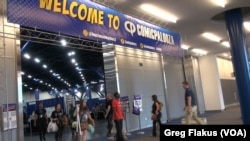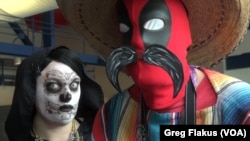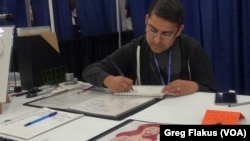Star Wars stormtroopers, Spiderman and Lara Croft from Tomb Raider were among the characters wandering the halls of Houston’s downtown convention center from June 17-19 at Comicpalooza, a convention that brings together fans of comic books, fantasy and horror books and films, and computer games with people who love to dress up as fantasy characters, known as cosplayers.
Comicpalooza began as a small gathering of comic book fans at a local movie theater in 2008. The founder and chief organizer of Comicpalooza, John Simons, told VOA he took on the task because Houston was, at that time, one of the few major cities that did not have such an event.
“I was a comics retailer,” Simons said, “and I had no show to go to. I knew that there was a real void in the market in Houston, so that is what prompted me to start thinking about this seriously.”
Rapid growth
Two years after the first small event, Comicpalooza exploded into a gathering of more than 10,000 fans from all over Texas and moved to the convention center. The event now attracts more than 40,000 people for its three days of panels and programs.
At this year’s event such celebrities as Kate Beckinsale of the “Underworld” vampire movies and Dominic Cooper of the popular television series “Preacher” were on hand. There was also a reunion of principle cast members from the 1986 movie “Aliens,” including Sigourney Weaver, Bill Paxton and Michael Biehn.
Simons said the breadth of the event provides something for everyone.
“We have tried to incorporate a variety of interests that speak to many different fandoms because we see this as a very open event that appeals to almost everyone who is out there enjoying pop culture,” he said.
Comicpalooza and other such events around the country were inspired by the success of San Diego’s ComicCon, the nation’s largest comic book convention, which started in 1970 and now draws well over 150,000 people a year. The biggest international event is considered Japan's ComiKet, an event held in summer and winter that draws about a half-million people.
A draw to artists
Many of the established artists who had booths at Comicpalooza were there to meet fans and sell original works. Others came to show their works in hopes of developing loyal fans.
A Houston high school teacher Eden Bautista spent much of his time making sketches at his booth while waiting for people to stop by and check out his work.
“This is just a hobby,” Bautista said. “I do have my daytime job, but I actually am getting better at it and I am starting to make a little money from it.”
At another booth, former commercial artist Daniel Shaw showed off a wide range of detailed fantasy figures on posters and T-shirts he has been producing and selling for 20 years. He has worked mostly with music groups who want artwork for an album cover or poster, but he is also working on his own comic book.
“With a comic, you are pretty much the director, the writer, the costume guy; it is all one thing,” Shaw said.
Longer-form comics
Many readers today favor the longer-form comic book called a graphic novel, which has more emphasis on plot and character development.
One of the more prolific and successful graphic novelists is Los Angeles-based Matt Hawkins, who contracts artists from around the world to create the visual realization of his stories.
“I think comics is a very collaborative medium, it is sort of a merging of a writer’s and an artist’s vision,” he said.
Hawkins said he can measure the success of each book through sales and feedback from fans, but he says nothing compares to being at a comic convention and meeting fans in person.
“Fans are brutal,” he said. “They are brutal, but they are great. You learn what they like, what they don’t like, what characters they like. Some are more reserved, they just buy a book, get it autographed and leave, but some of them will come up and talk for an hour.”
Hawkins, who has a master’s degree in physics, grounds his “Think Tank” stories in real science, which he follows by reading about cutting-edge research.
"I like making scientists the heroes because we need more people in science in this country," he said.
Hawkins embraces new technology and he said the true realization of online, digital storytelling has yet to come and that it will most likely come from some teenager with a computer who comes up with something no one has ever seen before.










